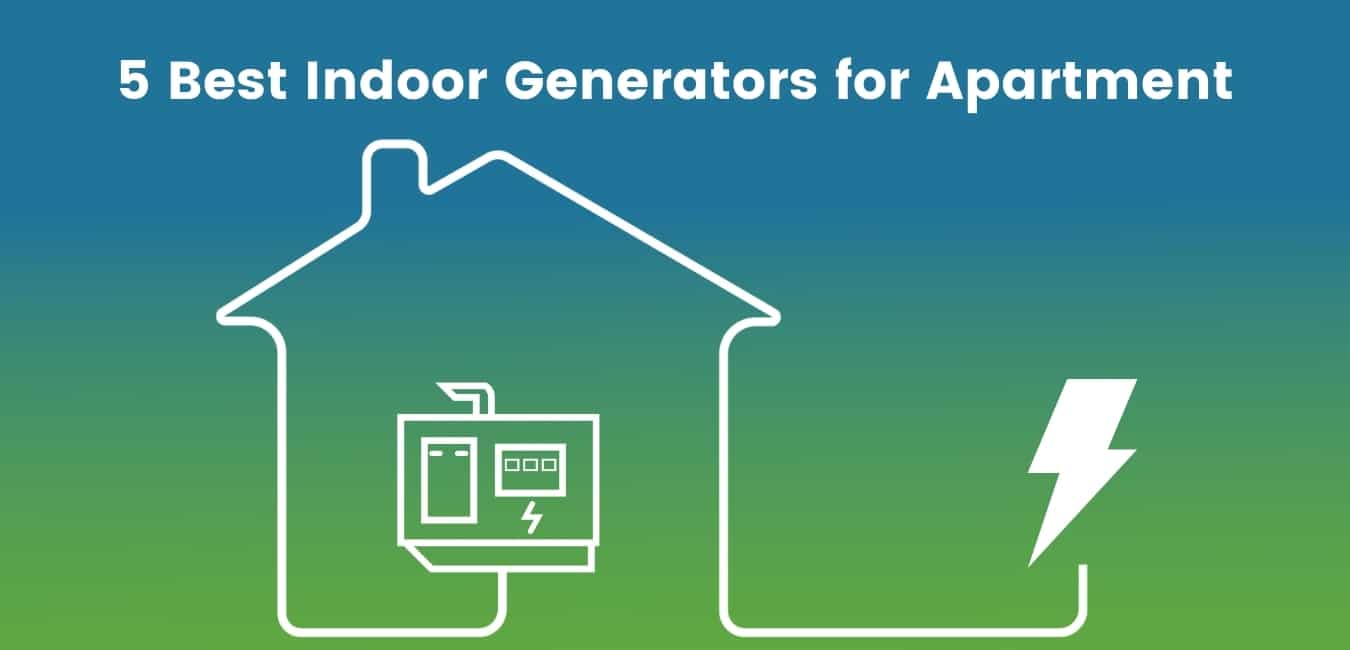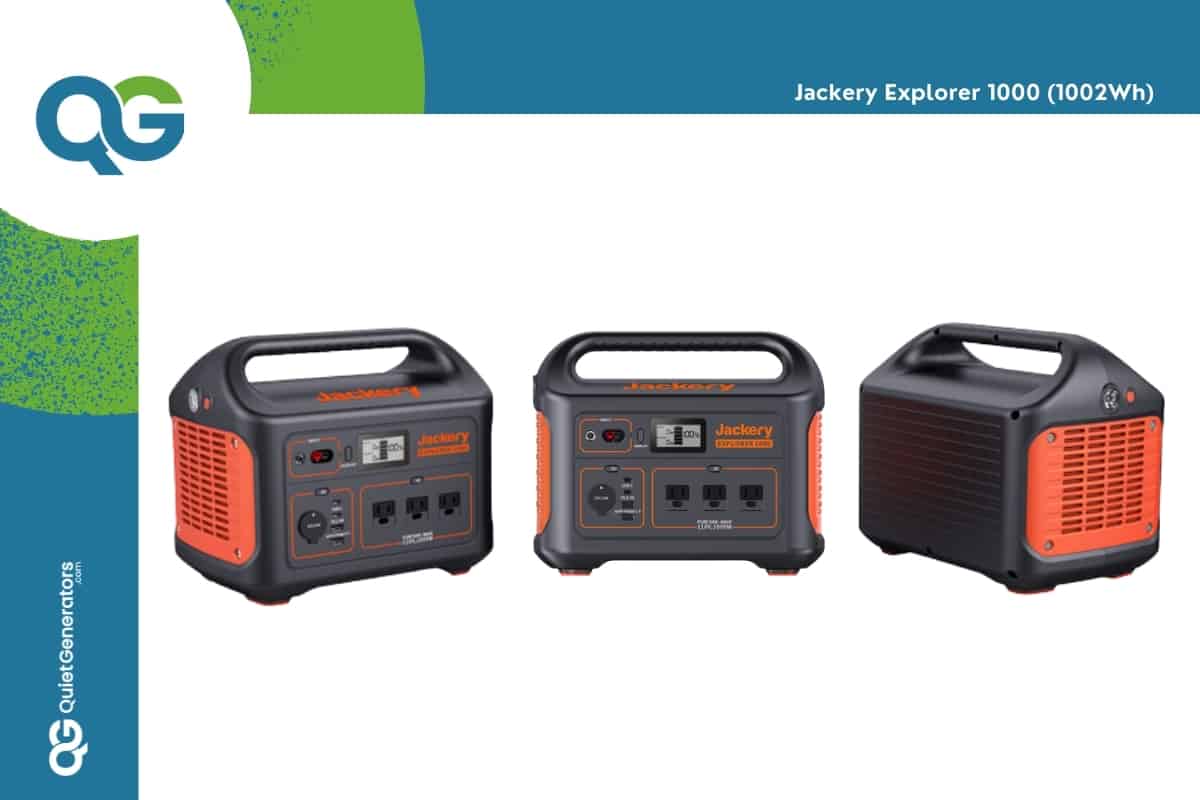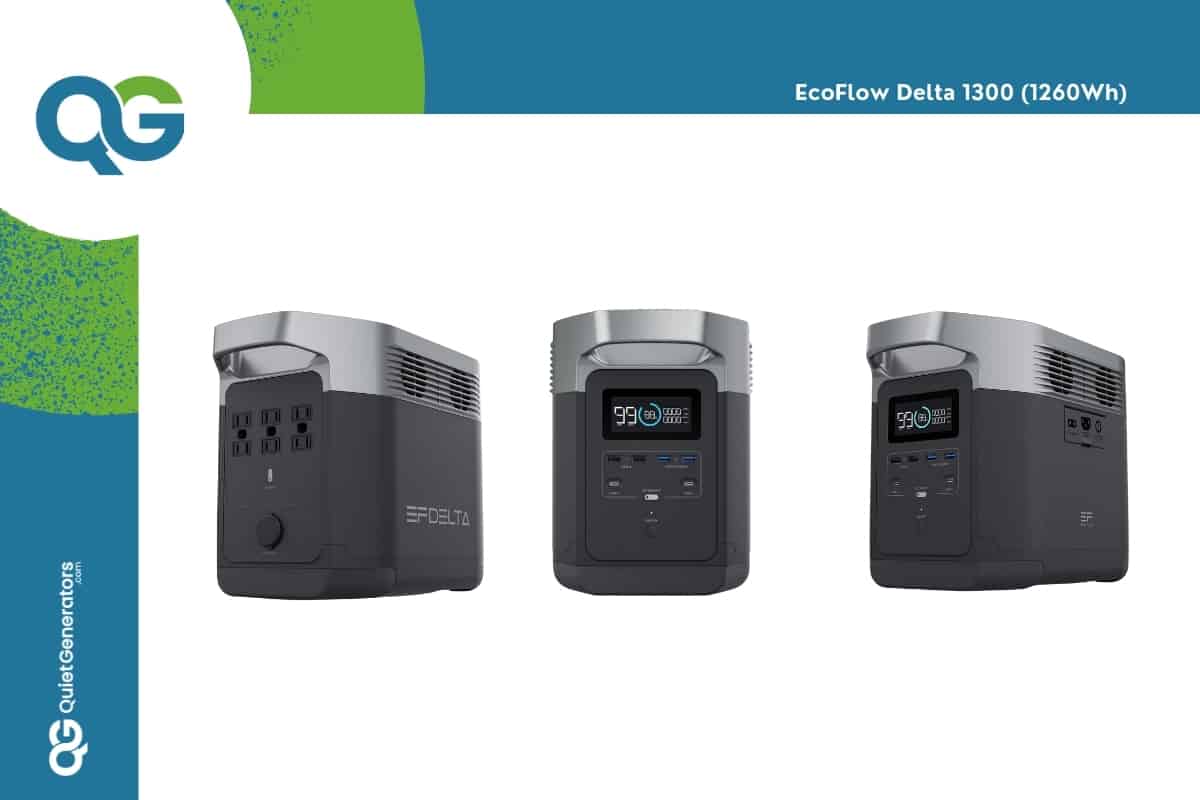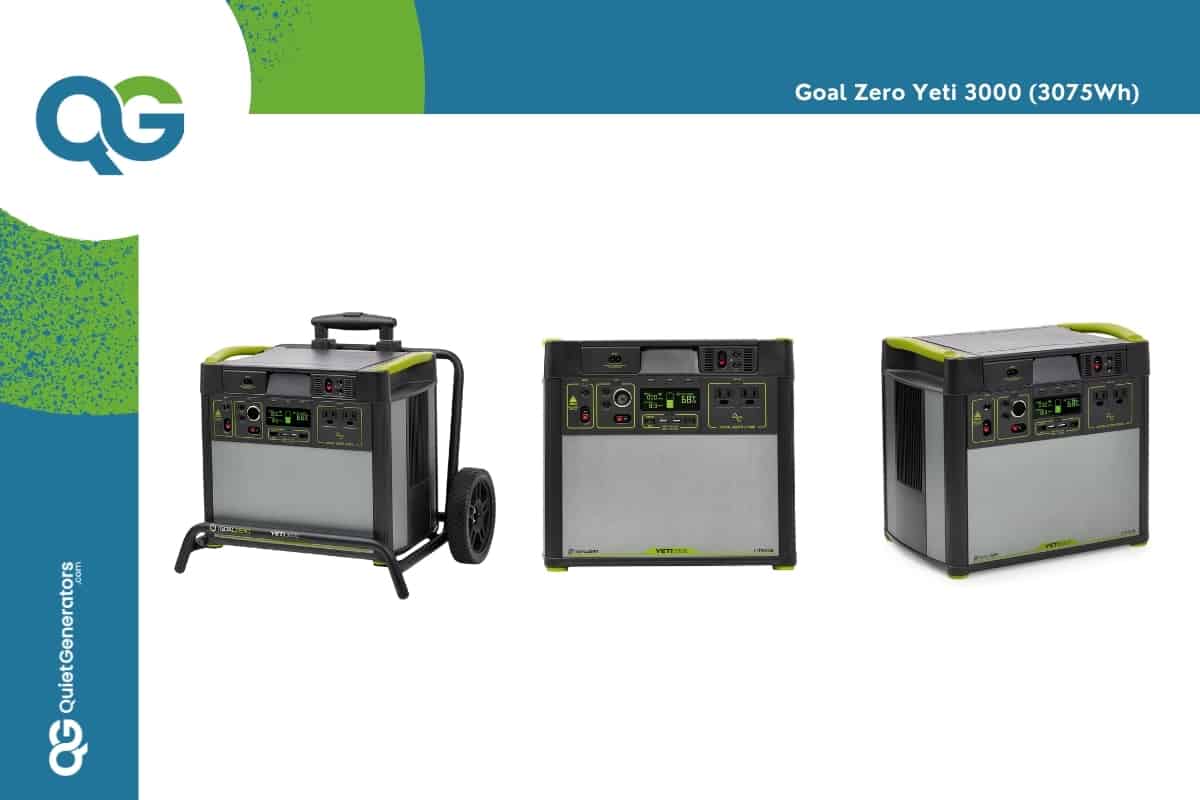Last Updated on July 21, 2023 by Rod Olivares

Not all apartments and condos have access to reliable power sources in case of emergencies like blackouts or storms. Most apartments don’t come with onsite backup generators, so when the power goes out, you’ll have to wait until the electricity comes back. When something like this happens, what’s the best generator for an apartment?
Gas-powered generators are the first thing that comes to mind in this type of situation, but they’re not always the best option for some people. They’re noisy, and they rely on gas, which means you can only use them outdoors.
The most alarming thing to keep in mind is that they emit carbon monoxide, which can kill a person in minutes. What makes it more dangerous is that you can’t see or smell the fumes.
That’s why you should never run a gas-powered generator indoors or even in partially enclosed areas like your apartment or condo balcony, to name a few.
But not to worry, there are generators for apartments and indoor use! Battery-powered generators are a practical alternative for people living in apartments and condominiums.
They don’t need gas or emit fumes – making them perfect for indoor use. Most can be recharged by plugging them into an outlet or with solar panels.
In this article, you’ll learn a few things about how to safely use generators indoors, which type of generator is best to use inside an apartment, and a handful of our top picks.
Safety Tips To Consider When Using Gas-Powered Generators

Gas-powered generators are a great way to provide power when the grid goes down, but they have their own dangers that you should be aware of. Keep these safety tips for using backup generators in mind:
- Avoid using generators in enclosed or even partially enclosed spaces such as a basement or garage. Carbon monoxide can quickly accumulate in these areas, making it fatal for anyone who goes in to turn the generator on and off.
- Make sure the generator is at least 10 feet away from your home while it’s running. Carbon monoxide can seep through open windows or vents and into your home. And because it’s colorless and odorless, it might be too late before you realize it.
- Keep children and pets away from the generator. Standing or playing around the generator can be dangerous because they might inhale the carbon monoxide from the generator’s exhaust.
- Mind the power cords and make sure they’re away from any foot traffic. Someone might trip on the lines or it might cause electrocution.
- Keep the generator dry at all times. Water and generators do not mix and can become a fatal combination.
However, we can avoid all (or at least most) of these problems by picking the right generator for our apartment or RV.
Battery-powered generators are safer than gas-powered ones because they don’t produce exhaust, but there are a few safety guidelines to keep in mind when using them too. When using battery-powered generators, be sure to keep these things in mind:
- Always keep the generator and its accessories dry. As mentioned before, water and generators do not mix! You might risk electrocution. Moisture inside the unit can also cause short circuits, component failure, fire, or even an explosion.
- Do not expose the generator to high heat or extreme cold. The ideal operating temperature is between -20°C and 60°C. Anything above that may cause a fire or explosion, while anything below may severely impede the generator’s performance.
- Wait for the unit to cool to room temperature before charging. After a heavy load, the generator’s temperature may be too high, which may prevent the unit from charging properly. The ideal charging temperature range is between 22°C to 28°C. To prevent any accidents, don’t leave it unattended during charging!
- Don’t insert pins, wires, or small metal pieces inside the unit. Metal objects might short circuit the generator.
- Never disassemble, puncture, shock, crash, or incinerate the generator. Doing that may cause a leak or an explosion. To avoid dangerous situations, always handle your generator with care.
- Never place heavy objects on top of the generator. Be sure to supervise children or people with disabilities around the generator.
- Fully charge and discharge the battery at least once every 3 months to keep the battery healthy. This means you should use your generator to its full capacity once every 3 months. The battery life of the unit may be reduced if it is left unused for an extended period of time.
Recycle and dispose of the device according to local regulations. If your generator can no longer turn on properly, or if the battery has been over-discharged, dispose of the unit safely and immediately. Batteries are hazardous chemicals so be sure to follow local regulations regarding battery disposal and recycle.
What Kind Of Generator Can You Use In An Apartment Or Condo?

Depending on your budget and the amount of power you need, battery-powered generators (or portable power stations) are your best option for an apartment.
For starters, these generators don’t make any noise, and they don’t emit any toxic fumes, making them perfect for indoor use!
In fact, battery-powered generators are the only type of generator that’s safe to use indoors.
You can also opt for standby generators. They usually run on propane or natural gas, which means they have to be installed outside.
What’s good about standby generators is that they automatically turn on when the power goes out, reducing your worries. However, they are more expensive and will require installation and regular maintenance. You also have to check with your landlord to see if it’s allowed.
Battery-powered generators are essentially large rechargeable batteries – about the size of a microwave. They generally have enough capacity to power small appliances for a few hours. And you can recharge them with solar panels or by simply plugging them into an outlet.
The 5 Best Indoor Generators For Apartment Use
Whether you’re looking for a portable indoor generator or simply the best generator for apartments to charge your devices during an emergency, or perhaps you’re looking for one that can keep your fridge running when the electricity goes out, we’ve narrowed down the 5 best battery-powered generators you can use in your apartment or condo.
1. Jackery Explorer 500 (518Wh)

The Jackery Explorer 500 is great for those on a tight budget who want to charge their electronics when the power’s out.
It won’t be able to power your whole apartment, but it does offer excellent value at its price point and can charge multiple small devices, such as laptops, phones, and cameras.
It can also power a mini cooler or a TV for a few hours. It’s capable of operating reliably between 32-104°F, so you don’t have to worry about it overheating on very hot days.
It’s a compact and lightweight power station, weighing only 14 lbs, and about the size of a handheld radio. It’s not too difficult to carry around in your backpack.
To charge it, you just need to plug it into a wall outlet. It’ll take around 7-8 hours for it to become fully charged.
Alternatively, you can use a portable solar panel kit. Under full sunlight, it will take 16 hours for it to reach 100% battery power.
One of the nice things about it is its built-in LED flashlight, perfect for navigating in the darkness during a power outage. It also has a digital display that shows you exactly how much battery charge is left so you can plan ahead.
The Jackery Explorer 500 comes with:
- 1 x 110V AC outlet
- 2 x 12V DC outlets
- 3 x USB ports
- 518Wh battery capacity
2. Ego Power+ Nexus (840Wh)

The Ego Power+ Nexus is a versatile power station that can meet your apartment and condomium needs for most short-term power outages. However, it might not be enough for longer blackouts or disaster situations.
With 3,000W of surge power and 2,000W of continuous power, the Nexus can comfortably power a refrigerator, microwave, or TV for a few hours.
With its highly modular design, the Nexus can function both indoors and outdoors. Equipped with four detachable lithium batteries, it’s flexible enough for travel or fitting in limited storage.
Similar to other battery generators, you can charge it by plugging it into an outlet. But there’s an extra step. Since the batteries are detachable, you have to attach them to the unit’s built-in battery charging station first. It takes about 7 hours for two 7.5 Ah batteries to become fully charged.
Unfortunately, it doesn’t support solar power charging natively. You can buy a solar power adapter to make it possible, although it’s not as good as charging via an outlet.
At 70 lbs, the Nexus might be best to keep in one place so you don’t have to move it around when you need to use it. A good idea is to put it near the appliance you want to power first in case of a blackout.
The Ego Power+ Nexus comes with:
- 3 x 120V AC outlets
- 4 x USB ports
- 840Wh battery capacity
3. Jackery Explorer 1000 (1002Wh)

The Jackery Explorer 1000 is a great alternative to its 500W counterpart. It can keep small devices powered longer and can power a standard refrigerator for a few hours, enough to keep your food from spoiling until the electricity comes back.
It boasts a continuous power output of 1,000W which is sufficient for most electronics and some small appliances. However, it won’t be able to keep up with high-power appliances like microwaves or heaters.
For its maximum power output, it’s relatively lightweight at 22 lbs. You can carry it up and down the stairs with no problem. You might not be able to fit this one inside your backpack, though.
You can charge it the same as the others – via an outlet or solar panels. The good thing is it comes with MPPT technology that allows faster solar charging. Expect to have it fully charged in about 8 hours using either method.
Like the Explorer 500, the Jackery Explorer 1000 also comes with a digital display showing you how much battery charge it has left.
Here’s everything it comes with:
- 3 x 110V AC outlets
- 2 x USB-A ports
- 2 x USB-C ports
- 1 x DC 12V car outlet
- 1,002Wh battery capacity
4. EcoFlow Delta 1300 (1260Wh)

The EcoFlow Delta 1300 doesn’t just look good, it has some amazing capabilities for a portable power station. The unit comes equipped with 13 outlets for charging devices simultaneously.
The Delta 1300 is unlike any other power station on the market. It’s around the mid-price point for battery-powered generators but offers great value for money in comparison.
This powerhouse can run most appliances and tools with ease considering its impressive surge capacity of 3,300W and continuous power of 1,800W. If your budget allows it, this is a great choice for your apartment.
To give you an idea, it can power a standard refrigerator for about 6-8 hours, and it can even power your microwave!
Not only that, the Delta 1300 charges 10 times faster than most of its competitors. Its fast charging time means you can go from empty to full in just 1.7 hours when you charge it via outlet and around 4 hours via solar panels.
It’s on the heavier side at 31 lbs, although still lighter than most power stations with this capacity.
The Delta 1300 comes with:
- 6 x AC outlets
- 4 x USB-A ports
- 2 x USB-C ports
- 1 x DC 12V car outlet
- 1,260Wh battery capacity
5. Goal Zero Yeti 3000 (3075Wh)

With a whopping 3,075Wh battery capacity, the Yeti 3000 can keep your refrigerator running for 2 whole days. It features six charging ports that can easily power multiple devices at the same time.
With that amount of power, it functions more as a backup power generator rather than a portable generator.
Weighing at around 68 lbs, it’s better to place it near the appliances you want to power during an outage to avoid the trouble of moving it around too much.
It takes 18 hours for it to become fully charged if plugged into an outlet. It also supports solar power charging, taking 6-20 hours until it reaches 100% battery capacity, depending on weather conditions.
A nice thing about the Yeti is that you can reduce its solar charging time by 40% if you use it with Goal Zero’s own portable solar panels. Not only that, you can boost the Yeti’s energy storage capacity by connecting lead-acid batteries to the unit.
If you don’t mind the higher price point, the Yeti 3000 is a good, reliable option during blackouts in your apartment. Here’s what it comes with:
- 2 x AC outlets
- 2 x USB-A ports
- 2 x USB-C ports
- 1 x DC 12V car outlet
- 3,075Wh battery capacity
Frequently Asked Questions
What is the best generator for an apartment?
We covered the five best indoor generators for apartments we recommend a few paragraphs back. But in a nutshell, the best generator for an apartment is lightweight, quiet, easy to use, efficient, and isn’t gas-powered!
What to do if power goes out in apartment?
If power goes out in an apartment, the first thing to do is properly shut off all appliances, lights, and electronics to prevent an overload when the power returns. If you have a battery–powered generator, as discussed above, it is best to use it frugally to provide enough power only for what you need.
Can I run a generator on my balcony?
Well, a battery-powered generator, yes, but that almost defeats its purpose, right? Just use that one indoors!
Now, using a gas-powered generator on a balcony is not recommended due to noise and environmental hazards. If the generator emits carbon monoxide, that’s a huge liability because you have neighbors all around you. If you have access to the rooftop and you are absolutely certain there is no one around, you could do that.
Can a small generator power a fridge?
Yes, it can, depending on the generator’s maximum power output or starting wattage capacity. If your refrigerator requires 1,000 starting wattage, then a generator with a starting wattage capacity above that will work.
To give you an idea, the average starting wattage of a standard refrigerator is around 800-1,200W. So a generator with 1,300W maximum power output will run most refrigerators.
What generator size do I need for my apartment?
It really depends on what you need to power during a blackout or emergency. If you need a generator to keep the fridge running and maybe a few lights, then you might need a unit with at least 1,000W capacity to keep them powered for about 3-5 hours.
But If power outages are short (less than 2 hours), then you can probably get by with something less, especially if you’re only using them to charge small devices (you can use our generator size calculator for more accurate numbers).
Can you use a generator outside apartment?
If it’s far enough, maybe. But you need to be extremely mindful of your neighbors and people who might pass by. Think about the noise level and time of day. If you have at least 25 to 30 feet of clear distance beyond your apartment, and there is no other buildings behind or around you, it might be possible. However, we only recommend it in extreme circumstances.
Can you use a generator in an apartment?
A gas-powered generator, NO! Absolutely NOT. Nothing that runs on gasoline, propane, diesel, or natural gas. Don’t even think about it, please!
Do condos allow generators?
No. Most common generators such as gas-powered will not be allowed inside or near condominiums. You must use a battery-powered generator in your condo. It can be portable, just battery-powered.
Can a generator be used indoors?
Yes, but only battery-powered generators can be used indoors. Never ever use gas-powered generators inside your house or RV. Exhausts from gas generators contain poisonous carbon monoxide fumes that can kill you in minutes.
How long will my generator keep running?
Battery capacity is measured in watt-hours (Wh). If a generator has 500Wh, that means it can power a 500-watt appliance for 1 hour, or a 100-watt device for 5 hours.
That’s why it’s important to know which appliances you need to run as well as how much wattage those appliances consume before you decide.
How long do I need to charge my generator?
The time required to fully charge a generator depends on its wattage capacity. It can take anywhere between 7 to 20 hours when plugged into an outlet.
How do I charge my generator using solar panels?
To charge your portable power station using solar panels, make sure that your solar panel kit and generator are compatible. Sometimes you might have to hook up a conversion adapter on the panel in order for it to work properly. However, if your generator supports solar power charging, then it can be as simple as plugging it in. Be sure to follow the instructions in the user manual.
Can I charge multiple devices at once?
It depends on the number of power outlets or charging ports your generator has. If you have multiple devices that require an AC outlet, then you don’t want a generator that only has one AC outlet.
Alternatively, if you plan to charge devices that use USB cords like your smartphone, then it makes sense to choose a generator that includes at least one USB port in addition to an AC outlet.
Do apartments have generators?
Generally, no; apartments do not have generators. A few high-rises or other apartment buildings may have a centrally located generator to power security lights, lifts, and other building facilities, but individual apartments do not typically have their own generators. This is why we recommend having a battery-powered generator in your apartment in case of emergency.
Wrapping Up
If you’re looking for a generator to use in your apartment, inside your house or on the road in your RV, choose a battery-powered generator.
The most important thing is to understand how many watts of power you need during an outage. Plan ahead by taking note of how often and how long power outages in your apartment occur.
If you only need to power small devices like phones or laptops during an outage, then the Jackery Explorer 500 will do just fine.
But if you’re looking for something bigger with more capacity to run heavy-power appliances like a refrigerator or heater, be prepared to spend some money on the Goal Zero’s Yeti 3000. If you don’t mind a shorter runtime, the Ego Power+ Nexus can do the job too.
For a good balance between the two, either the Jackery Explorer 1000 or EcoFlow Delta 1300 will satisfy most needs. In any case, you can’t go wrong with any of the battery-powered generators in this article.
Consider your power needs and budget before you decide which one to buy. Hopefully, this article has made it easier for you to choose!

Scott Krager purchased generatorgrid.com in the summer of 2020 and quickly began to buy every generator under the sun! He currently has over a dozen generators and the number is growing quickly. He lives in Portland, OR near his family and friends.
GeneratorGrid.com is an independent review business. I am not affiliated with any manufacturers and do not accept paid reviews. When you buy through my links, I may earn a commission which helps me purchase more generators for testing. - Scott Krager


Hi Scott,
Brand new looking into a generator for back up purposes for my home. My question is if I’m using a solar generator with pass through capabilities connected to my main electrical box is there a way to power a few outlets/appliances through solar at the same time running the rest of electrical sources in the house off the grid? Saving me a few $$ especially during the Spring & Summer seasons.